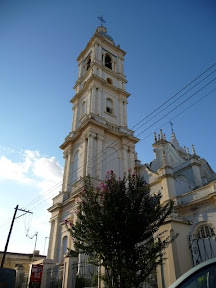I got off the bus in Salta, a picturesque colonial town which reminds of the famous towns in the sierra in Mexico. The main difference is that it is not located in a high altitude dessert, but in a subtropical valley.
Let me show you around town: Fine colonial buildings from outside
and inside,
during the day
and at night:
Those of you who have already been to Central America (probably with me) will be reminded of beautiful places such as Zacatecas, Guanajato, Oaxaca, San Christobal De Las Casas, or Antigua. You can also find the colorful markets here that make the mentioned places so charming:
There's great food at the markets, such as empandas, humitas, tamales, etc. The first night in Salta I joined a BBQ which organized by my hostel staff. Let me just give you the facts: lomo (finest filtes) as much as you can eat, 2 bread, and one salad per person for roughly five Euros. Isn't that crazy, I mean not only this incredible cheap steaks (in Germany I would have paid 100 Euros for the all the meat I ate) but also the meat to non-meat ratio in the BBQ. I will miss Argentina ;(
Besides being a stunningly beautiful colonial town, Salta also offers spectacular nature right out of town. Together with a Canadian couple I hired a small car and a local guide that showed us the way to a town called Cachi and also all the highlights on the way. When you leave Salta's valley, you quickly end up in narrow subtropical gorges, the yungas.
Then the road climbs a little, the valley opens up, and the scenery gets a little arider.
As usual when you get higher up, condors are circling above your head. I took the opportunity to ask our guide (Esteban) what condors are really capable of doing. I heard so many rumours about condors killing people, horses etc. Fact is that condors can easily kill and carry away little goats and sheeps, but Esteban has never heard of children being attacked by a condor...
At the following picture you can see me standing high above the valley (at 3300 m) and also the road leading up there. Isn't it a charming place? Another sweet mountain bike route ;)What a freaky scenery with the cardones and the snow-capped 6000 m high Cachi Mountains in the background, isn't it? If you examine the next picture thoroughly you will find exactly four "West Coast Signs", where are they? If you want a hint, then zoom to my hands ;)
and of course magnificient sceneries:
A llama, isn't it? Or what do you say, oll' pal?
To make it short, Cachi is a beautiful small Andean town set against picturesque mountains. A perfect place to hang out and enjoy the harmony of architecture and nature.
And of course to enjoy Cachi's famous local product - chilli:
There is also some hiking around Salta's yungas down in the valley. But believe me it is tropically hot and humid down there:
I hiked up Salta's local mountain, Cerro San Bernardo. Take a close look at the next picture, can you see the spiders everywhere?
No? Well, then you might need another closer picture. Can you see them now?
These spiders are literally everywhere and almost reach the size of my hand. Spooky isn't it? Apparently there are also some really dangerous snakes around here. Luckily, I didn't meet any of them ;)
I just stayed a short time in Salta since the place I actually want to go is on the Chilean side of the mountains - the Atacama dessert. Nevertheless, Salta was a cool and relaxing stop on my route, where I found a picturesque city in an even more beautiful surrounding.
Flo


































No comments:
Post a Comment